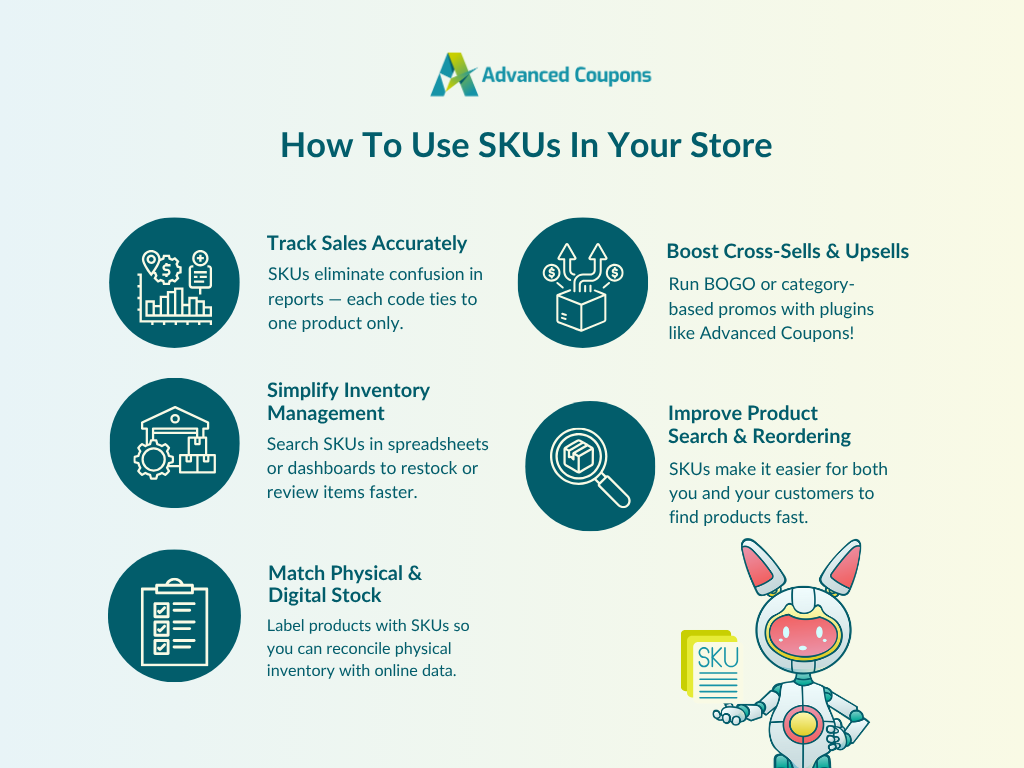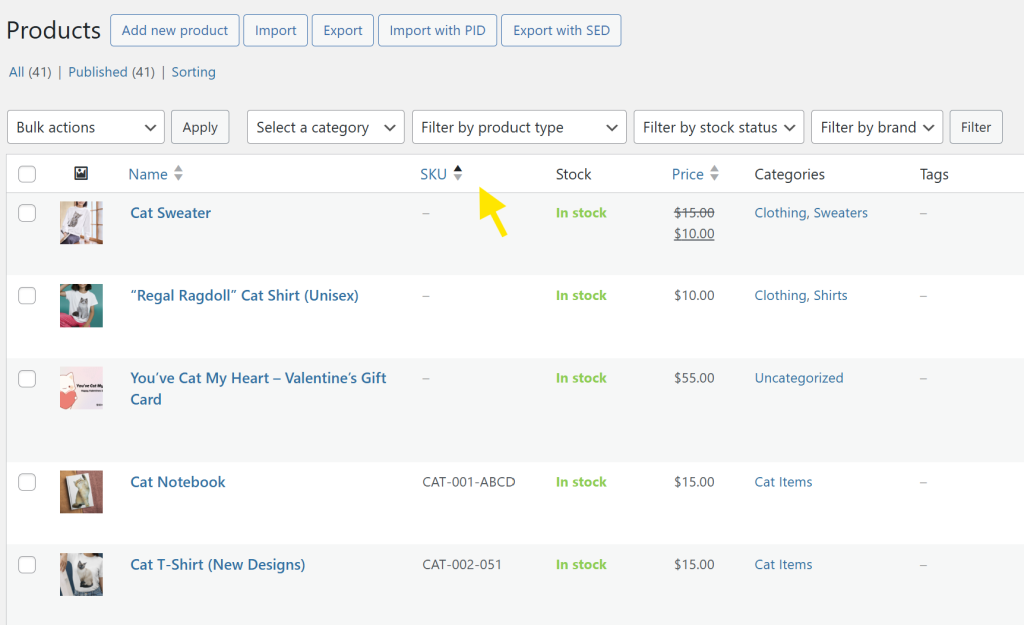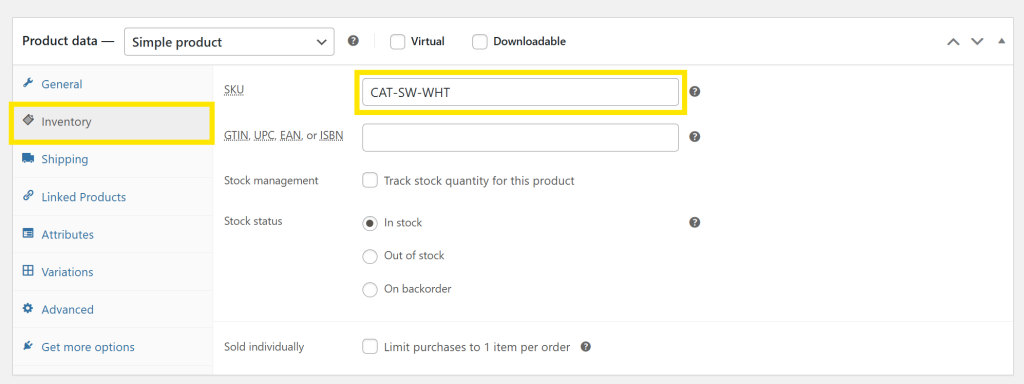
If you’re working on your first WooCommerce store, you might be curious about what an SKU number is. SKU stands for Stock Keeping Unit, and it’s a term that you’re going to run into repeatedly while processing inventory and doing accounting.
In this article, we’re going to answer what what is an SKU code is and how they play into e-commerce. You’ll also learn how to generate, assign, and manage WooCommerce SKU numbers. Let’s get to it!
What Is An SKU Code?
SKU numbers (short for Stock Keeping Unit) are unique codes that store owners assign to their products for better catalog and inventory management.
Each item in your catalog should have its own SKU code. That way, there’s no risk that you’ll confuse similar products when doing inventory or when updating your store. Names alone can be too vague, so usually, you’ll rely on numbers.
The types of SKU numbers that you’ll see will vary from one store to another. That’s because SKU codes are for internal use only.
If you want to create an effective management system, you can’t simply come up with random SKU numbers for each product. Instead, you want to assign specific numbers for each product depending on its taxonomy. That way, you’ll be able to glean information from products by their SKU code alone.
How To Use SKUs In Your ECommerce Store
An organized store is a happy store. However, using SKU codes in WooCommerce isn’t simply about scratching an itch for your organization. Using SKU codes can help you manage your store more effectively in several ways, including sales analysis.
1. Increased precision in sales reports
Most software enables you to check up on sales and which products are more popular among clients. However, if you have several products with similar names, reading sales reports can get confusing.
Using SKUs removes any potential confusion from sales reports. An SKU can only correspond to a specific product, which means there’s no way that you’ll mistake one item’s sales for another’s.
2. Inventory management
Although e-commerce plugins such as WooCommerce can help you keep track of inventory, we also recommend keeping your own records. Spreadsheets can make inventory management a lot easier.
As your store grows, inventory spreadsheets can become very hard to navigate. Even if you search tools to find specific products, you run the risk of confusing entries due to their names or similar product attributes.
SKU numbers will enable you to find the exact products that you’re looking for.
That way, you’ll be able to check stock numbers at a glance and know when to restock products or which items you might want to discontinue.
3. Matching physical inventory with stock numbers
A lot of times, products go missing.
You might also run into the occasional defective item that you can’t sell to customers. Although e-commerce software is great at helping you keep track of overall inventory, it can’t identify missing or defective stock. That’s something that only humans can do by checking physical inventory manually.
Ideally, each product should have an SKU number label.
That way, it’ll be easier to match the physical stock to the records that you keep using e-commerce software or your favorite spreadsheet program. Running manual inventory will help you reconcile the numbers in storage with the stock available for sale on your website.
Those numbers should always match and if they don’t, there should be an explanation for it.
4. Helps with upselling and cross-selling
Aside from helping you maintain a more organized inventory, SKUs can also support your promotional strategy! Well-defined and consistent product SKUs across your catalog help you spot and group related items together. This makes a huge difference when you’re setting up product recommendations in your store, ramping up your upsell and cross-sell strategy.
Let’s say you’re selling tumblers in your online store and want to recommend accessories like caps or lids. With well-defined SKU patterns, you can quickly find compatible items and offer them as add-ons.
🎯 POWER TIP: You can run promotions based on product categories or attributes to highlight specific products or move excess inventory. Plugins like Advanced Coupons allow you to launch targeted discounts on specific products and craft BOGO deals for related items, which is perfect for cross-selling and upselling.
5. Better search and filtering in your store
As your store grows, your product catalog will likely expand with it. It can start to get tricky when you’re sifting through hundreds of similar items on your store’s backend, especially when you have products with similar names and variations. SKUs can help by serving as unique product identifiers. By searching for a specific product SKU, you can pull up the right item instantly.
It’s a huge time saver for customers, too! If you’re serving wholesalers, for instance, you can enable SKU search on your storefront to help them reorder quickly.
💡 GOOD TO KNOW: Plugins like Wholesale Order Form for WooCommerce allow you to offer a bulk ordering form with SKU filters so your B2B buyers can find exactly what they need faster.
How To Create SKU Codes For Your Store
The process of creating and adding SKU codes can vary depending on which platform you’re selling on. In WooCommerce, for instance, you can assign SKU codes manually per product listing (we’ll cover the process in the next section). Shopify works similarly, allowing you to allowing you to enter SKUs when adding or editing products in your dashboard.
Since you’re in charge of the store, you can assign products to any SKU number that you want. However, we recommend creating a basic system that will enable you to keep SKU codes organized.
The easiest way to do this is to assign numbers and/or alphabetical values to your product taxonomy. For example, if you have the following taxonomy…
T-Shirt > Large > Blue
…that can correspond to an SKU number that looks like this:
TS-LG-BL
Usually, SKU numbers are separated into several sections. Each section should tell you a unique piece of information regarding that product if you know how to read it.
Keep in mind that there’s no one universal method for coming up with SKU codes. Since these numbers are for internal identification purposes only, you’re supposed to come up with a system that makes sense to you and that is easy to understand.
For clarity’s sake, we recommend that you keep SKU codes relatively short. On that same note, you’ll want to separate each section in SKUs with a hyphen, so the overall number is easier to read.
How To Add WooCommerce SKU Numbers
Adding SKU numbers in WooCommerce is simple. If you go to the All Products tab, you’ll notice there’s an SKU column next to the product’s names:
By default, WooCommerce will use product name slugs as SKU codes. To change the SKU code for a product, select it and click on Edit. Once the product editor is open, scroll down to the Product data widget. Select the Inventory tab and look for the SKU field to the right:
After adding an SKU number to your product listing, don’t foget to click Update.
Keep in mind that WooCommerce will let you assign any type of SKU that you want. You can enter any mix of numerical and alphabetical symbols. However, the SKU number that you assign should correspond to the product’s taxonomy.
If you’re unsure about how to come up with an SKU number, go back to our section on how to create SKU codes for your store.
The numbers that you choose can be as simple or as complex as you need. However, the larger your store is and the more products that you have in inventory, the longer the SKU numbers tend to be.
Checking your WooCommerce taxonomy settings
An SKU number in WooCommerce can start with the product category, then move on to the individual product name, and end with the product attribute. That’s precisely the format that we followed in our earlier example.
If you’re not sure about your WooCommerce store’s taxonomy system, you can easily check up on it. To do so, open the dashboard and into the Products > Categories, Products > Tags, and Products > Attributes sections:
Best Practices For SKU Management
After we’ve answered what an SKU code is and how they work on WooCommerce, you’re likely excited to add them to your product catalog! Here are a few best practices to keep in mind:
Use a consistent format
Follow a consistent format to avoid confusion. Most store owners create SKUs based on product taxonomy, which means they contain information like product category, color, or size. For instance, a large black T-shirt may have a simple SKU of TS-LG-B. Following the same format will help your team quickly decode what each SKU means at a glance.
Avoid using special characters
Special characters like &, #, @, or * can cause issues when exporting data into CSV files or importing them into inventory management tools. Sticking with alphanumeric characters (A–Z, 1–9) is your safest bet. If you need separators, go with hyphens (-) or underscores (_). They’re easier to read and universally accepted by most tools and plugins.
Don’t reuse old SKUs
The golden rule is that each SKU should stay tied to a single, unique product. Recycling SKUs can create confusion in past sales insights, inventory records, and customer service reports. Even if one of your products gets discontinued, it’s better to assign a fresh code to new listings, even if they’re similar to this old product. Doing so keeps your data clean and ensures inventory tracking stays accurate across all your systems.
Update SKUs periodically
As you expand your product catalog, you might add new product categories or change up some naming conventions based on product attributes. If old SKUs no longer reflect how your store is organized, it might be time to update them. It’s likely not an overnight process, as this takes careful planning and consideration. Make sure to keep a detailed log of every SKU update and communicate changes clearly with your team.
SKU VS Other Retail Codes
SKUs are one of the most common product identifiers in WooCommerce, but you may also come across terms like UPCs and GTINs if you’re selling on marketplaces or working with suppliersrs. It’s important to know the differences so you can choose which system is best for your store.
SKU vs UPC
SKUs are unique to each store—you come up with your format and assign them for each item in your product catalog. UPCs (Universal Product Codes), on the other hand, are global product identifiers. They’re always 12 digits and are assigned to products by manufacturers or brand owners through a central authority, such as GS1.
SKU vs GTIN
GTINs (Global Trade Item Numbers) are another global product identifier, also assigned by GS1. These codes can be either 13 or 14 digits, depending on the region, and are typically required by international platforms like Google Shopping or Amazon. Unlike SKUs, which are created and assigned by individual store owners, GTINs are universal and remain consistent across the global supply chain, no matter who sells the product.
SKU vs Barcodes
Barcodes are machine-readable black lines that retailers scan at checkout. They typically “contain” a globally recognized product identifier like UPC. SKUs, on the other hand, are created and managed internally by store owners. They aren’t standardized—you can decide the format based on what your store needs.
Frequently Asked Questions About SKU Numbers
If you still have any questions left about SKU numbers, this section will answer them. Let’s start by talking about the differences between SKU numbers and barcodes.
Are SKU numbers and barcodes the same?
SKU numbers are codes that stores use for internal product identification. Every store can have a unique SKU code system. That means different stores can sell the same products, but they can have entirely different SKU codes. Barcodes are universal. They’re unique identifiers at the product level that stores can’t modify.
How do I get an SKU for my products?
Depending on the e-commerce software that you use, it may generate SKU numbers automatically for you. If you’re using WooCommerce, you’ll need to assign SKU numbers manually. However, you have complete freedom on what type of numbers to assign.
Is there a universal system for SKU numbers?
Every store can come up with its own system for assigning SKU numbers. Ideally, these numbers should reflect information about the product and how each store classifies it.
Conclusion
SKU numbers play a significant role in keeping your online store organized and searchable. By assigning unique WooCommerce SKU codes, you can track inventory, analyze sales, and improve your upselling and cross-selling efforts. In this guide, we covered everything you need to know about SKUs, including:
- What is an SKU code?
- How to use SKUs in your store
- Creating SKU codes
- How to add WooCommerce SKUs
- Best practices for SKU management
- Differences between SKUs and other retail codes
Do you have any questions about SKU numbers? Let’s talk about them in the comments section below!









